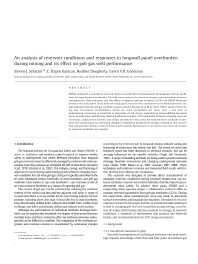Mining Publication: An Analysis of Reservoir Conditions and Responses in Longwall Panel Overburden During Mining and its Effect on Gob Gas Well Performance
Original creation date: February 2012
NIOSH conducted a cooperative research study to provide direct measurements of changing reservoir conditions in longwall panel overburden. The field measurements documented changes in permeabilities, methane concentrations, fluid pressures, and the effects of adjacent gob gas ventholes (GGVs) on NIOSH boreholes drilled in the study panel. Three different stratigraphic horizons were monitored by the NIOSH boreholes. Results indicated that the gob gas venthole fracture network formed 24 to 46m (80 to 150 ft) ahead of the mining face. Overburden permeabilities within the same overburden test zones were ~1md prior to undermining, increasing to hundreds or thousands of md during undermining. Permeabilities measured seven months after undermining showed additional increases. The relationship between changing reservoir conditions, longwall face position, and surface movement is discussed. Recommendations are made to optimize GGV performance by evaluating changes in subsidence produced by mining, resulting in rock stresses that substantially influence induced fracture permeability. Mechanisms to account for the observed changes in reservoir conditions are reported.
Authors: SJ Schatzel, CÖ Karacan, HN Dougherty, GV Goodman
See Also
- Coal Mine Methane: A Review of Capture and Utilization Practices with Benefits to Mining Safety and to Greenhouse Gas Reduction
- Development and Application of Reservoir Models and Artificial Neural Networks for Optimizing Ventilation Air Requirements in Development Mining of Coal Seams
- Effect of a Surface Borehole on Longwall Gob Degasification (Pocahontas No. 3 Coalbed)
- Longwall Gob Degasification With Surface Ventilation Boreholes Above the Lower Kittanning Coalbed
- MCP - Methane Control and Prediction - 2.0
- Remote Methane Sensors
- Reservoir Rock Properties of Coal Measure Strata of the Lower Monongahela Group, Greene County (Southwestern Pennsylvania), from Methane Control and Production Perspectives
- Stochastic Modeling of Gob Gas Venthole Production Performances in Active and Completed Longwall Panels of Coal Mines
- Three Coal Mine Gob Degasification Studies Using Surface Boreholes and a Bleeder System
- Two-Phase Flow in Coalbeds
- Content source: National Institute for Occupational Safety and Health, Mining Program


 ShareCompartir
ShareCompartir
